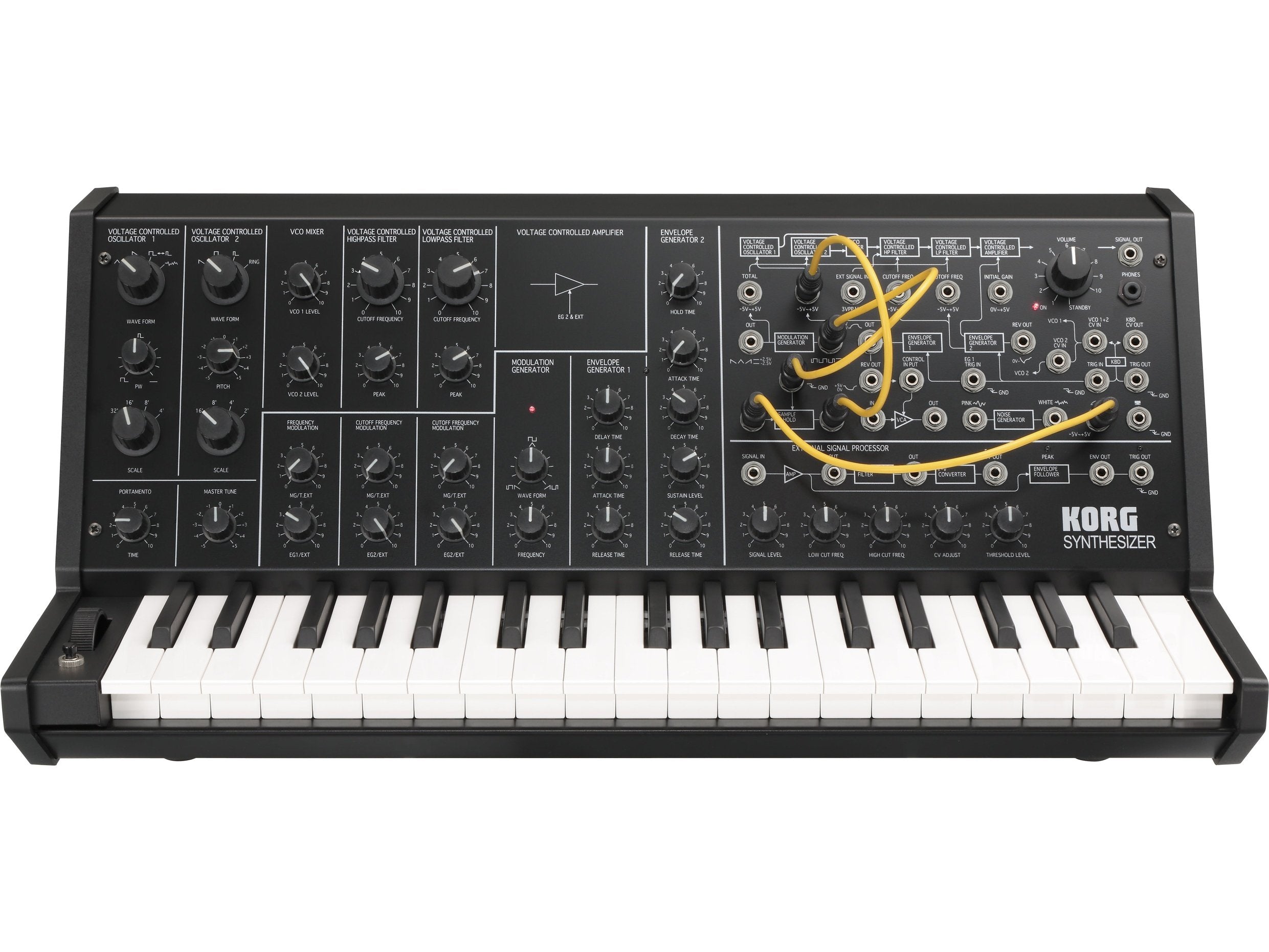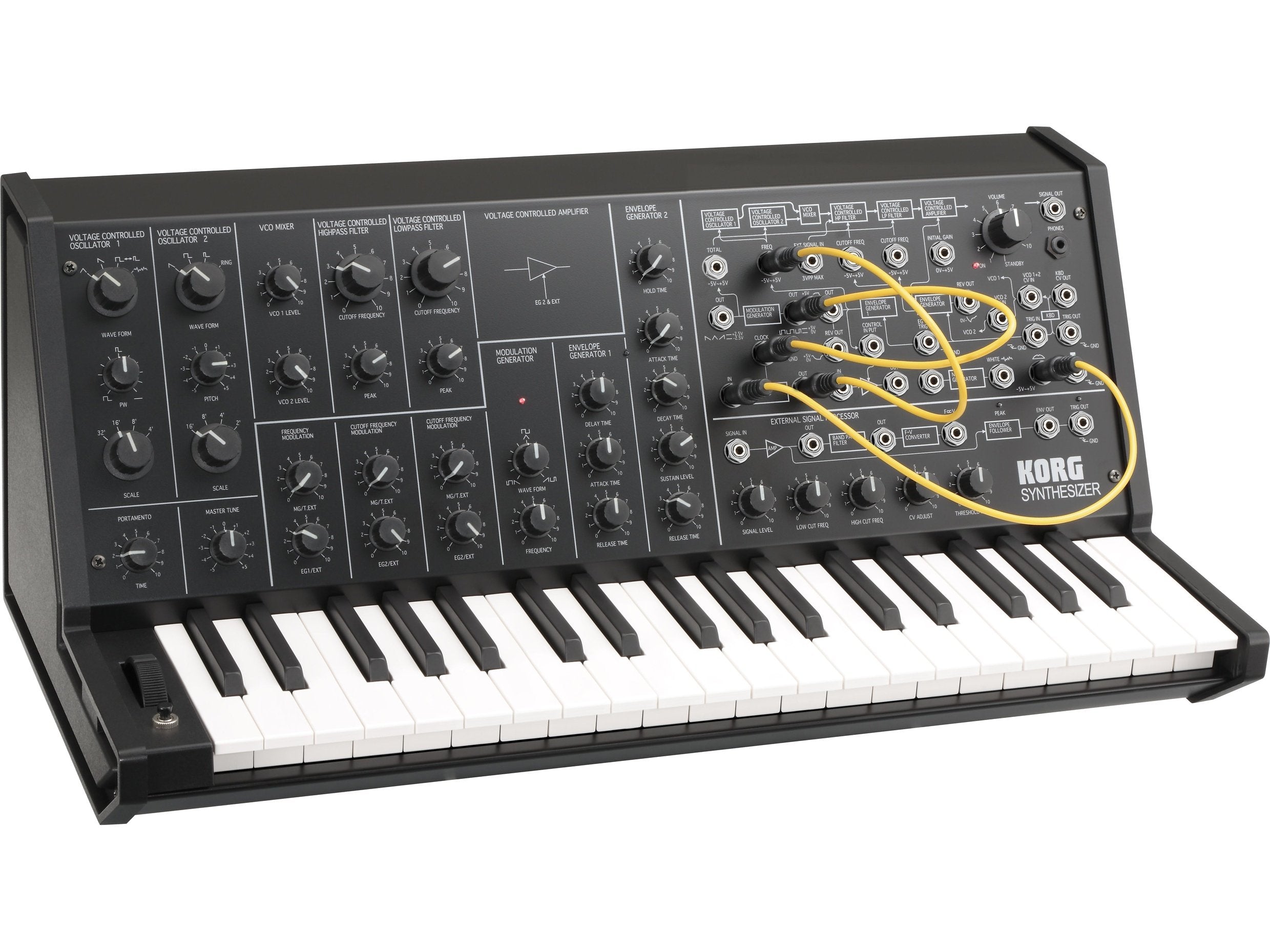




MS-20 mini
Korg’s MS-20 monophonic synthesizer, released in 1978, is still a coveted instrument to this day, thanks to its thick, robust sound, powerful, iconic analogue filters, and versatile patching options. It is reborn in the MS-20 Mini, with the original engineers perfectly reproducing its circuitry in a slightly downscaled body, for a new generation.
Extend your warranty for free when buying direct from Korg UK. Find out more.
Free 30-day returns available on all products. Find out more.


The classic MS-20 –recreated in mini size!
An analogue synthesizer that reproduces the original circuitry from 1978

Korg’s MS-20 monophonic synthesizer, first introduced in 1978, is still a coveted instrument to this day, thanks to its thick, robust sound, its powerful, iconic analogue filter, and its versatile patching options.
Over 300,000 people have enjoyed the distinct MS-20 sounds from the original, from Korg’s MS-20 plug-in synth, and the iMS-20 iPad app.
Today, the sounds of the MS-20 have been reborn as the MS-20 Mini. The same engineers who developed the original MS-20 have perfectly reproduced its circuitry and fitted it into a body that’s been shrunk to 86% of the original size, yet retains the distinctive look of the original that remains unfaded despite the passage of time.
The MS-20 mini will amaze you with its absolutely authentic analogue synth sound.
Comments from the developers
Fifty years have passed since Korg was founded, and we have once again put our hand to an analogue synthesizer. We took particular care to deliver smooth parameter adjustments, which are a distinctive feature of analogue synthesizers. We also took special care to completely reproduce the original specifications of the MS-20. The analogue circuits we designed 35 years ago still deliver the same unbeatable, powerful sound, from the ultra-low to the ultra-high range.

The original analogue circuitry
The MS-20 mini painstakingly replicates the original MS-20. A development team led by the original engineers themselves worked to recreate the original circuitry, and when it was necessary to substitute a part, these engineers made the decisions based on careful listening, in order to reproduce the original sound faithfully.
In fact, the sound of the MS-20 mini has a somewhat bright and extreme quality to it because its sound is that of an original MS-20 in mint condition at the time it went on sale, before any of the components aged.

2VCO / 2VCF / 2VCA / 2EG / 1LFO structure
The MS-20 mini reproduces the distinctive synthesis of the MS-20; two oscillators with ring modulation, and envelope generators with hold and delay. The VCA maintains the basic design of the original, but it’s been modified to produce less noise than the original.
Self-oscillating high-pass/low-pass filters with distinctive distortion
One of the greatest characteristics of the MS-20 was its powerful filters, which provided resonance on both the high-pass and the low-pass. Maximising the resonance would cause the filter to self-oscillate like an oscillator, producing a distinctive and dramatic tonal change that was acclaimed as inimitable, and was later used on the monotron and monotribe.
The filter circuit was changed mid-way through the production lifecycle of the MS-20; the MS-20 mini uses the earlier filter, which was felt to be superior due to its more radical sound.

External signal processor (ESP) for processing an external signal
The ESP carries on the experimental spirit of MS-20; it allows you to use the pitch or volume of an external audio source to control the synthesizer. For example you can input an electric guitar and use the MS-20 mini as a guitar synthesizer, or input a mic and use it as a vocal synthesizer.

Extremely flexible patching system
The patching system provided to the right of the panel lets you create complex sounds by plugging-in cables to change the connections between the various units. The possibilities are limited only by the user's imagination; different combinations of the modulation input/output and trigger, sample and hold, and noise generator can produce an incredible variety of sounds. By patching according to the MS-20 flow chart that’s printed on the panel, even the beginner can start taking advantage of these possibilities right away.

86% of the original size
MS-20’s design concept started by borrowing from the vertical layout found on larger and more expensive modular synths of its time, and then creating a more portable, inexpensive, and easier to use version.
To make it even more approachable, the MS-20 mini has been shrunk to 86% of the size of the original MS-20. In spite of its smaller size, meticulous care has been taken to accurately reproduce the knob design and the printing. The patch cables have been changed from 1/4" phone plugs to mini-plugs, and the newly-designed keyboard is also 86% of the original size.
Replicates every detail of the original
Our effort to remain faithful to the original is not limited to the unit itself. Even the package that contains the unit replicates the original as far as possible.
Also included are the original MS-20 owner's manual and settings chart, explaining how to create sounds. Now you can experience the excitement of the MS20, just like it was during its original release in 1978.

MIDI IN connector and USB connector
The MS-20 mini provides a MIDI IN jack for receiving note messages, and a USB-MIDI connector that can transmit and receive note messages. You can even connect the MS20 mini to your computer and play it from a sequencer.
Audio
More information
Specifications
Control Section
Keyboard
C – C: 37-notes (3 octaves), mini keyboard designed specifically for the MS-20 mini
Voltage Controlled Oscillator 1 (VCO 1)
Scale (32', 16', 8', 4') (6 octaves, +cent, -cent)
Wave form (Triangle, Sawtooth, PW-Square, White Noise) (4 modes)
Pulse width adjust 1:1 - 1:infinity
Voltage Controlled Oscillator 2 (VCO 2)
Scale (16', 8', 4', 2') (6 octaves, +cent, -cent)
Wave form (Sawtooth, Square, Pulse, Ring modulator) (4 modes)
Pitch (± 1 octave)
VCO Master Control
Master tune (± 100cent)
Portamento (max. 10sec)
Frequency modulation intensity by MG/T.EXT (-5V - +5V)
Frequency modulation intensity by EG1/EXT (-5V - 0V)
VCO Mixer
VCO 1 Level
VCO 2 Level
Voltage Controlled High Pass Filter (VCF HPF)
Cutoff frequency (50Hz - 15,000Hz)
Peak (flat - self OSC)
Cutoff frequency modulation intensity by MG/T.EXT (-5V - +5V)
Cutoff frequency modulation intensity by EG2/EXT (-5V - +5V)
Voltage Controlled Low Pass Filter (VCF LPF)
Cutoff frequency (50Hz - 15,000Hz)
Peak (flat - self OSC)
Cutoff frequency modulation intensity by MG/T.EXT (-5V - +5V)
Cutoff frequency modulation intensity by EG2/EXT (-5V - +5V)
Envelope Generator 1
Delay time (10sec)
Attack time (10sec)
Release time (10sec)
Envelope Generator 2
Hold time (20sec)
Attack time (10sec)
Decay time (10sec)
Sustain level (0V - 5V)
Release time (10sec)
Modulation Generator (LFO)
Wave form (Positive Sawtooth - Triangle - Negative Sawtooth, Wide Pulse - Square - Narrow Pulse)
Frequency (0.1Hz ~ 20Hz)
Manual Controller
Control wheel (centre click)
Momentary switch -->GND
Power Switch and Volume
Volume
Indicator
LED (KBD trigger, Modulation Generator rate, Power ON)
External Signal Processor
Control Section
Input signal level
Low cut frequency (50Hz - 2,500Hz)
High cut frequency (100Hz - 5,000Hz)
CV adjust
Threshold level
Input and Output
Signal In
Amplifier Out
Band pass filter Out
CV Out (0 - +8.4V)
ENV Out (0 - +5V)
Trig Out (+5V-->GND)
Indicator (LED)
Peak indicator
Trigger indicator
Patch Panel
Keyboard
Keyboard control voltage output (Exponential) (0 - +8V)
Keyboard trigger output (+5V-->GND)
VCO-1 + VCO-2 control voltage input (Linear response) (0 - +8V)
VCO-2 control voltage input (Linear response) (0 - +8V)
VCO
VCO-1 + VCO-2 external frequency control input (OCT/V) (-5V - +5V)
VCF
External signal input (3Vp-p max.)
External High pass filter cutoff frequency control input (2OCT/V) (-5V - +5V)
External Low pass filter cutoff frequency control input (2OCT/V) (-5V - +5V)
VCO + VCF
Total external modulation input (T.EXT) (-5V - +5V)
VCA
External initial gain control input (0 - +5V)
EG
EG 1 envelope signal normal output (-5V - 0V)
EG 1 envelope signal reverse output (+5V - 0V)
EG 1 + EG 2 trigger input (-->GND)
EG 1 trigger input (-->GND)
EG 2 envelope signal reverse output (+5V - 0V)
MG
Triangle output (Positive Sawtooth - Triangle - Negative Sawtooth) (5Vp-p)
Rectangle output (Wide Pulse - Square - Narrow Pulse)(0 - +5V)
Noise Generator
Pink noise output (5Vp-p)
White noise output (5Vp-p)
Sample and Hold
Clock trigger input (-->GND)
Sample signal input (5Vp-p max.)
S/H output (5Vp-p max.)
Modulation VCA
Control voltage input (0 - +5V)
Signal input (-5V - +5V)
Signal output (-5V - +5V)
Manual Controller
Control wheel output (-5V<--0V-->+5V)
Momentary switch output (-->GND)
Signal Out
Signal output (mono 1/8" mini phone jack, 2Vp-p output impedance 3.5k Ω)
Headphones
Headphones output (Stereo 1/8" mini phone jack, 33 Ω 48mW)
USB
Type B, USB-MIDI Input/Output
*Only note messages (velocity is not used) can be transmitted and received.
MIDI
MIDI Input
*Only note messages (velocity is not used) can be transmitted and received.
Others
Power Consumption
9W
Power Supply
DC9V
Dimensions (W x D x H)
493 × 257 × 208 mm / 19.41 x 10.12 x 8.19 inches
Weight
4.8 kg / 10.58 lbs.
Accessories
AC adaptor (9V/1.7A), Patch Cord x 10
Returns
We offer a 30-day returns period on all products purchased directly from Korg UK.
Specifications and appearance are subject to change without notice.
All product names and company names are the trademarks or registered trademarks of their respective owners.